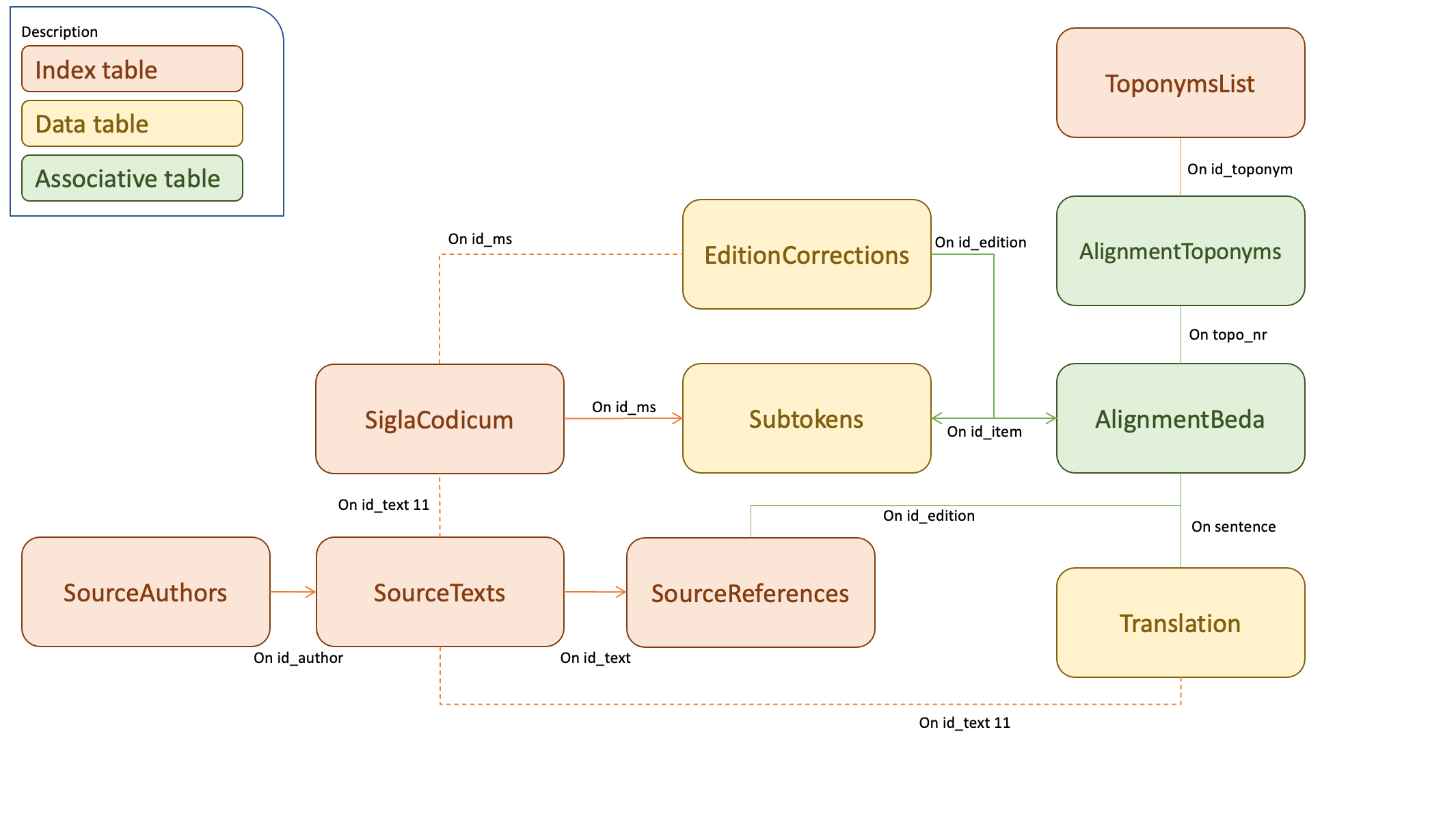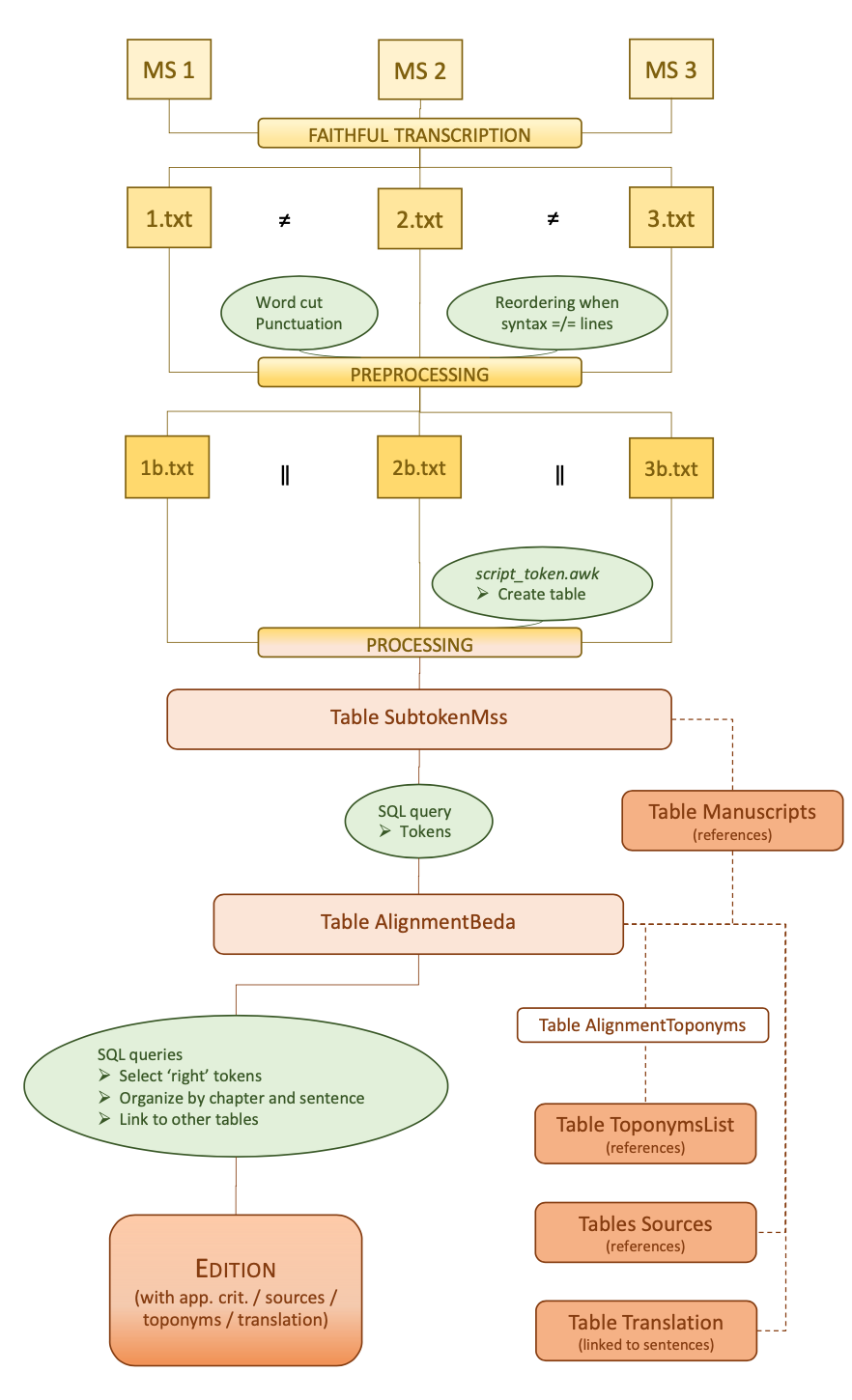This website holds the results of a two-year project, graciously funded by the Humboldt Foundation, led at the Ludwig-Maximilians-Universität in Munich. It consists in a new critical edition of The Venerable Bede's De locis sanctis, with information about the manuscripts, an index of every placename cited in the text and a bibliography.
How to use this site
Under Critical Edition in the menu, you may find 5 versions of the text:
- Latin Text: the plain edited Latin text, with reproductions of the floor plans as drawn in Ms N.
- Apparatus: the edited Latin text with its apparatus criticus. Each word is linked to the variants table: by clicking on a word in the text, you get the corresponding line in the table, showing you each manuscript version of the word. If you click on any Edited word in the table, it takes you back to the right line in the text. The apparatus table contains only expanded versions of the words; to get more information about the abbreviations and ligatures in the manuscripts, go to the Manuscripts tab.
- Sources: each sentence of the text is given alongside the references of the passages Bede copied, abridged or paraphrased. A link to an online edition of the source is given whenever possible (CSEL - from the Open Greek and Latin Perseus Digital Library, Patrologia Latina - on archive.org, the Vulgate - from the Academic Bible website).
- Toponyms: each reference to a place in the text is linked to its information sheet: by clicking on a highlighted term, you get an overview of the location, its alternate names, if Bede gives more than one denomination, and a short commentary.
- Translation: an original French translation is given opposite to the Latin text.
Under Manuscripts:
- The list of all the manuscripts containing the De locis sanctis.
- The full Apparatus criticus, indicating the abbreviations used in the manuscripts.
- A visualisation of the transcriptions, to get an idea of the length and disposition of each manuscript.
Under Toponymy:
- A map representing every place cited by Bede that could be located with certainty.
- An index of Latin placenames, linked to the sentences where Bede mentions each site.
- An index of the placenames (in alphabetical order of the English translation of the placename), linked to the information sheet of each site.
To know more about the model used to created the edition, see below under Method.
The project
About Bede the Venerable
Bede (c. 672-735) was an English Benedictine monk from Northumbria. Most of what is known about his life comes from the last chapter of his own Historia Ecclesiastica. At the age of 7, he was sent as an oblate to the monastery of Wearmouth to be educated by Benedict Biscop. As Ceolfrith founded the sister monastery of Wearmouth at Jarrow in 682, Bede was transferred to the new abbey. He was ordained deacon at the age of 19, and became a priest at 30 (c. 702). While he travelled to various abbeys and monasteries across the British Isles, most notably to York, he spent most of his life in the monastery, writing and teaching.
His very extensive work, touching on many different subjects, gave him a long lasting reputation as the most influential scholar from Early Medieval England. He wrote scientific, historical and theological works, including biblical exegesis, computistical studies and hagiographical texts. Although Bede is mosly known as an historian now, being called "the Father of English History" thanks to his detailled Historia Ecclesiastica Gentis Anglorum, his texts on grammar and on chronology, alongside his scriptural commentaries, were read and largely copied in his time and during the Middle Ages. He was well versed in patristic literature (Jerome, Augustine, Ambrose, Gregory the Great), as well as pagan literature (Pliny the Elder, Virgil, Lucretius and other classical writers): he based his commentaries and studies on these previous works, but his texts were not devoid of original thought. As a teacher, Bede's motivation was clarity of exposition, and most of his works, even though his style might not always be simple, are clearly structured and written.
A list of Bede's works with the edition of reference, is available on the website of the monastery of Wearmouth.
About the De Locis Sanctis
Bede's first texts were language teaching materials, on orthography and metrics, a De natura rerum (701) and a report of the Holy Places, the De locis sanctis, probably written around 702-703. This opus, although quite short, is an example of Latin writing in the British Isles at the beginning of the eighth century. It connects with Bede’s other pedagogical writings and his willingness to teach his student “that creation is orderly and that phenomena on earth and in heaven can be explained rationally” (Stevens, BNP, 2006).
As a second-hand travel report – Bede never went to the Orient, but instead drew upon Adomnán’s report of bishop Arculf’s travels to Palestine, Hesegippus’ account and Ps.-Eucherius’ De situ Hierusolimae – this text invites the comparison, both in form and meaning, with his sources. Also, its afterlife during the Middle Ages may be of interest, as it is closely quoted by Peter the Deacon in the twelfth century. Finally, as a geographical description of the Holy Places, a study of the toponymy is imperative and encourages an evaluation of the similarities and disparities with Scripture, biblical commentaries and other reports concerning these sites.
The literary context: Latin travel literature
Travel literature covers a wide range of documents, from travel reports and guides to novels, which originated in several ancient genres: the periegesis, “a descriptive journey – in prose or in verse – around a place or an area or even the known world” (Drijvers, 2018: 366); itineraria, the description of roads, cities and stops, alongside discussions of cultural and anthropological aspects; and periplous, the same for maritime routes. If the periegesis and the periplous are of Greek origin, the itineraria appear to be mainly a Latin genre. These texts were written and used either by the military or by civilians, merchants or Christian pilgrims on their way to holy places. This corpus, which contains texts ranging from the fourth century to the Middle Ages, is heterogenous in form, including literary handbooks, lists of places and graphic maps. It is also worth noting, as only a few names and works have come down to us from Antiquity, that some pieces are written by – or in the voice of – women (such as the travels of Egeria). Despite this variety, the corpus may still be perceived as a whole because of the common theme all pieces share: the description of Roman territory as told or illustrated by a traveler. It may be organized in four main groups: the military written roadmaps, the inscriptions, the itineraria picta (the drawn maps) and the Christian pilgrims’ accounts, both the itineraria Hierosolymitana and the itineraria Romana (cf. Fugmann, 2001). The last group comprises the itineraries written by Christian pilgrims, themselves very diverse in form, ranging from short poems (Ennodius, Itinerarium Bringantonis castelli [CCXLV carm. 1,1] and Itinerarium Padi [CDXXIII carm. 1,5]) to complete reports of a pilgrimage enriched by spiritual considerations (Itinerarium Egeriae). In this ensemble, Bede’s De locis sanctis helps us shed a light on the similarities and the differences in Christian itineraries from Jerome’s time to the eighth century.
The literary quality of these writings varies greatly, depending on the literacy of the writer, his or her purpose – a pilgrim thinking upon his or her journey to the Holy Land will not have the same perspective and goal as a soldier describing the best marching route – and the period and place of production. Linguistically all the texts that have come down to us reflect late Latin, although there are undoubtedly stylistic differences between the first itinerarium (Itinerarium burdigalensis, 333) and the ones penned in the early Middle Ages (cf. Milani, 1997). We should also remark that Late Antiquity is defined by growing distance between spoken Latin, inevitably evolving through time, and written Latin, which remained more conservative, because of the role played by school, forever promoting the imitation of the classical literary authorities. The pilgrims’ itineraries display not only many references to Christian literature and sometimes even to classical pagan texts, but also features of the sermo vulgaris, the common speech. The literary topoi and references to Scripture are frequent in a series of texts describing the Holy Land and reflecting on the spiritual journey, but the language used by the pilgrims and monks appears to be far from Cicero’s Latin. Moreover, this corpus offers one of the best insights into the topography of the ancient world available today, as it gives accurate information about places and distances between them. Also, the reports on Holy Places describe the landscape and define where the sanctuaries are situated, as it was considered fundamental knowledge for understanding Scripture (Augustine doctr. christ. 2,58). As the itineraries are one of the main sources for research on ancient toponymy, it is important to produce clear and accurate editions of these texts.
Method
In addition to the conception of an adequate edition of the De locis sanctis, one of the main ideas behind this project was to use this work to find a way to construct a useful tool to represent and analyze how ancient authors, starting with Bede, created space through language. The questions we asked ourselves were the following: how to use and represent the data contained in the manuscript? How to construct a critical edition without losing each manuscript’s particularity? How to create a reusable model for other geographical texts?
Selection of manuscripts
According to Geyer’s description of the manuscripts in his introduction to the edition of the text (CSEL, 1898), it appears that there are two main groups of witnesses, ranging from the 9th to the 15th cent. The close reading of Fraipont’s edition (CCSL, 1965: 7 manuscripts, including the 4 chosen by Geyer, which he did not verify) showed that the apparatus criticus contained many mistakes. For this reason, our project started with the revision of this last edition, and a new reading and transcription of the manuscripts. So far, 5 of Fraipont's manuscripts have been transcribed and implemented (+ Li). Unfortunately, due to the Covid situation, we have not yet been able to read the manuscript from Milan nor the one from Bruges. We will keep on implementing manuscripts in order to offer a more complete analysis of the variants and if possible, a stemma.
Preprocessing of the text
Due to the shortness of the text, the transcription was manual. We normalized the punctuation and word separation to match modern standards before tokenizing the text through an awk script. The result of this process was a table giving, for each subtoken (either a full word or a cut word at the end of a line), information about its position on the page (manuscript, page number, line number, position in the line) and in the synctatic course of the text (chapter number, sentence number, position in the sentence). This raw data is the fundamental basis of the edition.
The relational database
We used a relational database (i.e. a structure that allows us to identify and access data in relation to another piece of data in the database, organized into tables) to build the edition and the indexes. We have 3 types of tables:
- The table containing the textual data: the latin text; the editorial corrections (for the normalization of spelling when no manuscript presents a viable variant: the list decreases with the implementation of new mss); the translation.
- The ones containing the data for the indexes: the sigla codicum; the textual sources; the list of toponyms mentioned by Bede.
- The associative tables, which link the indexes to the textual data.
Database visualisation:

Process visualisation:

The data is free to use under the CC BY-SA 4.0 license.